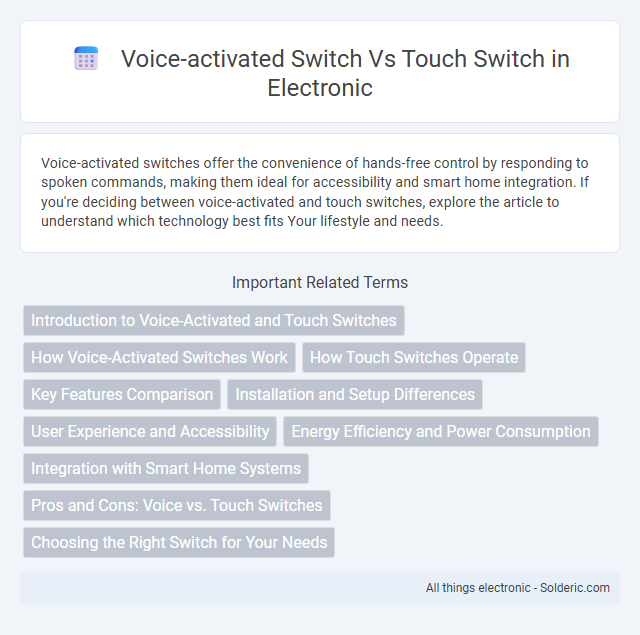Voice-activated switches offer the convenience of hands-free control by responding to spoken commands, making them ideal for accessibility and smart home integration. If you're deciding between voice-activated and touch switches, explore the article to understand which technology best fits Your lifestyle and needs.
Comparison Table
| Feature | Voice-Activated Switch | Touch Switch |
|---|---|---|
| Activation Method | Voice commands | Physical touch |
| Ease of Use | Hands-free, convenient | Requires physical contact |
| Technology | Microphone, voice recognition | Capacitive or resistive touch sensors |
| Power Consumption | Higher due to voice processing | Lower, minimal power usage |
| Installation | Complex, requires microphone integration | Simple, replaces traditional switches |
| Reliability | Dependent on voice accuracy and noise | Consistent, less prone to error |
| Cost | Higher initial cost | Lower initial cost |
| Use Case | Smart homes, accessibility | General use, quick manual control |
Introduction to Voice-Activated and Touch Switches
Voice-activated switches respond to vocal commands, enabling hands-free control of devices, which enhances accessibility and convenience in smart home environments. Touch switches operate through capacitive sensing, allowing users to activate devices with a simple tap, offering a sleek and modern interface without physical buttons. Both technologies integrate seamlessly with home automation systems, but voice-activated switches prioritize hands-free interaction, whereas touch switches focus on tactile engagement.
How Voice-Activated Switches Work
Voice-activated switches use voice recognition technology to detect spoken commands and convert them into electrical signals that control the device. These switches rely on microphones and embedded processors to analyze sound patterns, filtering out background noise for accurate activation. Integration with smart home systems enables seamless control without physical contact, enhancing convenience and accessibility.
How Touch Switches Operate
Touch switches operate through capacitive sensing technology, detecting changes in the electrical field caused by the human skin's conductivity when you touch the surface. This technology enables precise and responsive activation without mechanical parts, leading to greater durability and a sleek design. Compared to voice-activated switches, touch switches offer immediate tactile feedback and do not rely on voice commands or ambient noise conditions for operation.
Key Features Comparison
Voice-activated switches offer hands-free control using voice commands, enhancing accessibility and convenience for smart home integration. Touch switches provide tactile feedback with easy, direct interaction, often featuring customizable LED indicators and energy-saving modes. Both switch types support automation but differ in user experience, where voice switches excel in hands-free environments while touch switches provide immediate physical response.
Installation and Setup Differences
Voice-activated switches require integration with a compatible smart home system and Wi-Fi connectivity during installation, often involving app-based configuration and device pairing. Touch switches typically need direct wiring into the electrical system, with setup limited to physical installation and calibration for sensitivity. The voice-activated option demands greater initial technical setup, while the touch switch is more straightforward but lacks remote or hands-free control capabilities.
User Experience and Accessibility
Voice-activated switches enhance user experience by allowing hands-free control, making them highly accessible for individuals with mobility impairments or those multitasking in complex environments. Touch switches offer tactile feedback and intuitive operation but may pose challenges for users with limited dexterity or visual impairments. Incorporating voice recognition technology improves accessibility by enabling seamless interaction regardless of physical ability, while touch switches require precise contact, potentially limiting usability for some users.
Energy Efficiency and Power Consumption
Voice-activated switches typically consume less standby power than traditional touch switches, as they remain in low-energy listening mode until activated by voice commands. Touch switches often require a constant power draw to detect physical contact, leading to higher overall energy consumption. Choosing a voice-activated switch can optimize your energy efficiency by minimizing unnecessary power use during idle times.
Integration with Smart Home Systems
Voice-activated switches seamlessly integrate with popular smart home ecosystems like Amazon Alexa, Google Assistant, and Apple HomeKit, offering hands-free control and automation. Touch switches provide direct manual operation but often lack the same level of connectivity and remote access, limiting their role in comprehensive smart home setups. Your choice depends on whether you prioritize voice control integration or simple tactile interaction within your smart home environment.
Pros and Cons: Voice vs. Touch Switches
Voice-activated switches offer hands-free convenience and accessibility, especially useful for people with limited mobility, but they may struggle with background noise and require internet connectivity for some features. Touch switches provide tactile feedback and reliable operation without voice recognition errors, yet they can be less accessible for users with disabilities or when hands are wet or dirty. Your choice depends on prioritizing ease of use and accessibility versus reliability and simplicity in control.
Choosing the Right Switch for Your Needs
Voice-activated switches provide hands-free convenience and are ideal for accessibility and smart home integration, detecting commands through speech recognition technology. Touch switches offer a tactile and responsive experience, with ease of use and durability suited for frequent manual control in environments where voice commands might be impractical. Understanding your environment and usage preferences will help you choose the right switch that aligns with your lifestyle and enhances your daily interactions.
voice-activated switch vs touch switch Infographic

 solderic.com
solderic.com